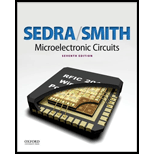
Microelectronic Circuits (The Oxford Series in Electrical and Computer Engineering) 7th edition
7th Edition
ISBN: 9780199339136
Author: Adel S. Sedra, Kenneth C. Smith
Publisher: Oxford University Press
expand_more
expand_more
format_list_bulleted
Concept explainers
Question
Chapter 4.5, Problem 4.20E
(a)
To determine
To prove: The output for full wave rectifier is zero at an angle of
(b)
To determine
To prove: The average value of
(c)
To determine
To prove: The peak current through each diode is
To find: The fraction change of each cycle for
Expert Solution & Answer
Want to see the full answer?
Check out a sample textbook solution
Students have asked these similar questions
7.48 Determine the Thevenin equivalent of the circuit inFig. P7.48 at terminals (a,b), given thatVs(t) = 12cos 2500t V,Is(t) = 0.5cos(2500t −30◦) A.
1. In the following closed-loop system, a PD controller of the form K(s + 5) is used. Design the gain K such
that the system achieves an overshoot of 16%. Calculate the settling time and peak time for the PD
controlled system.
Compensator
R(s) +
E(s)
Plant
1
C(s)
K(s+Zc)
(s+1)(s+2)(s+5)
Find Vo
Chapter 4 Solutions
Microelectronic Circuits (The Oxford Series in Electrical and Computer Engineering) 7th edition
Ch. 4.1 - Prob. 4.1ECh. 4.1 - Prob. 4.2ECh. 4.1 - Prob. 4.3ECh. 4.1 - Prob. 4.4ECh. 4.1 - Prob. 4.5ECh. 4.2 - Prob. 4.6ECh. 4.2 - Prob. 4.7ECh. 4.2 - Prob. 4.8ECh. 4.2 - Prob. 4.9ECh. 4.3 - Prob. 4.10E
Ch. 4.3 - Prob. D4.11ECh. 4.3 - Prob. 4.12ECh. 4.3 - Prob. 4.13ECh. 4.3 - Prob. 4.14ECh. 4.3 - Prob. D4.15ECh. 4.4 - Prob. 4.16ECh. 4.4 - Prob. 4.17ECh. 4.4 - Prob. 4.18ECh. 4.5 - Prob. 4.19ECh. 4.5 - Prob. 4.20ECh. 4.5 - Prob. 4.21ECh. 4.5 - Prob. 4.22ECh. 4.5 - Prob. 4.23ECh. 4.5 - Prob. 4.24ECh. 4.5 - Prob. 4.25ECh. 4.6 - Prob. 4.26ECh. 4.6 - Prob. 4.27ECh. 4 - Prob. 4.1PCh. 4 - Prob. 4.2PCh. 4 - Prob. 4.3PCh. 4 - Prob. 4.4PCh. 4 - Prob. 4.5PCh. 4 - Prob. 4.6PCh. 4 - Prob. D4.7PCh. 4 - Prob. D4.8PCh. 4 - Prob. 4.9PCh. 4 - Prob. 4.10PCh. 4 - Prob. D4.11PCh. 4 - Prob. 4.12PCh. 4 - Prob. 4.13PCh. 4 - Prob. 4.14PCh. 4 - Prob. D4.15PCh. 4 - Prob. 4.16PCh. 4 - Prob. 4.17PCh. 4 - Prob. 4.18PCh. 4 - Prob. 4.19PCh. 4 - Prob. 4.20PCh. 4 - Prob. 4.21PCh. 4 - Prob. 4.22PCh. 4 - Prob. 4.23PCh. 4 - Prob. 4.24PCh. 4 - Prob. 4.25PCh. 4 - Prob. 4.26PCh. 4 - Prob. 4.27PCh. 4 - Prob. 4.28PCh. 4 - Prob. 4.29PCh. 4 - Prob. 4.30PCh. 4 - Prob. 4.31PCh. 4 - Prob. 4.32PCh. 4 - Prob. 4.33PCh. 4 - Prob. 4.34PCh. 4 - Prob. 4.35PCh. 4 - Prob. 4.36PCh. 4 - Prob. D4.37PCh. 4 - Prob. 4.38PCh. 4 - Prob. 4.39PCh. 4 - Prob. 4.40PCh. 4 - Prob. 4.41PCh. 4 - Prob. 4.42PCh. 4 - Prob. 4.43PCh. 4 - Prob. 4.44PCh. 4 - Prob. D4.45PCh. 4 - Prob. 4.46PCh. 4 - Prob. 4.47PCh. 4 - Prob. 4.48PCh. 4 - Prob. 4.49PCh. 4 - Prob. 4.50PCh. 4 - Prob. 4.51PCh. 4 - Prob. 4.52PCh. 4 - Prob. 4.53PCh. 4 - Prob. 4.54PCh. 4 - Prob. 4.55PCh. 4 - Prob. D4.56PCh. 4 - Prob. D4.57PCh. 4 - Prob. 4.58PCh. 4 - Prob. 4.59PCh. 4 - Prob. D4.60PCh. 4 - Prob. 4.61PCh. 4 - Prob. 4.62PCh. 4 - Prob. D4.63PCh. 4 - Prob. D4.64PCh. 4 - Prob. D4.65PCh. 4 - Prob. D4.66PCh. 4 - Prob. 4.67PCh. 4 - Prob. 4.68PCh. 4 - Prob. 4.69PCh. 4 - Prob. 4.70PCh. 4 - Prob. 4.71PCh. 4 - Prob. 4.72PCh. 4 - Prob. D4.73PCh. 4 - Prob. D4.74PCh. 4 - Prob. D4.75PCh. 4 - Prob. 4.76PCh. 4 - Prob. 4.77PCh. 4 - Prob. 4.78PCh. 4 - Prob. 4.79PCh. 4 - Prob. D4.80PCh. 4 - Prob. D4.81PCh. 4 - Prob. D4.82PCh. 4 - Prob. D4.83PCh. 4 - Prob. D4.84PCh. 4 - Prob. 4.85PCh. 4 - Prob. 4.86PCh. 4 - Prob. 4.87PCh. 4 - Prob. 4.88PCh. 4 - Prob. 4.89PCh. 4 - Prob. 4.90PCh. 4 - Prob. 4.91PCh. 4 - Prob. 4.92PCh. 4 - Prob. 4.93PCh. 4 - Prob. 4.94PCh. 4 - Prob. 4.95PCh. 4 - Prob. 4.96PCh. 4 - Prob. 4.97P
Knowledge Booster
Learn more about
Need a deep-dive on the concept behind this application? Look no further. Learn more about this topic, electrical-engineering and related others by exploring similar questions and additional content below.Similar questions
- 3. Use MATLAB to generate the Nyquist plot for the following system. Then, apply the Nyquist stability criterion to determine the range of K values that ensure the stability of the closed-loop system. R(s)+ K C(s) (s+2) 1 (s + 4)(s+6)arrow_forward4. Please find the stability margins from the following Bode diagrams. Bode Diagram Phase (deg) Magnitude (dB) 50 -100 -90 -135 -180 -270 10" 10° Frequency (rad/sec) 10'arrow_forward2. Please use asymptotes to draw the Bode diagrams of the following transfer function. Please label the axes to show the cut-off frequencies and key values on vertical axes and label each asymptote with its slope. G(s) s+10 s(s²+10s+100)arrow_forward
- Find the Z-transform including the region of convergence for the following function 12 (¹)" [u(n) – u(n − 5)] -arrow_forwardFind the inverse Z-traform of X(z)= z 2 +z (z-0.125)³ (z-0.25)arrow_forwardA separately excited 6-kilowatt generator has a terminal voltage of 135V at no load. At full load, the terminal voltage is 120V with speed and field excitation unchanged. Armature resistance = = 0.25 ohm. A. What is the amount of voltage decrease caused by armature reaction and the voltage regulation?arrow_forward
arrow_back_ios
SEE MORE QUESTIONS
arrow_forward_ios
Recommended textbooks for you
 Electricity for Refrigeration, Heating, and Air C...Mechanical EngineeringISBN:9781337399128Author:Russell E. SmithPublisher:Cengage Learning
Electricity for Refrigeration, Heating, and Air C...Mechanical EngineeringISBN:9781337399128Author:Russell E. SmithPublisher:Cengage Learning

Electricity for Refrigeration, Heating, and Air C...
Mechanical Engineering
ISBN:9781337399128
Author:Russell E. Smith
Publisher:Cengage Learning